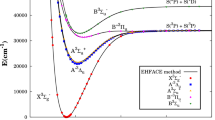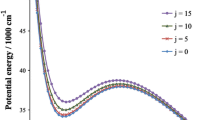Abstract
The description of Rydberg states by the complete active space self-consistent field (CASSCF) electronic structure method is known to be a difficult topic. In particular, two problems are frequently encountered: (a) the simultaneous presence of valence and Rydberg excited states in the same energy region can potentially lead to artificial valence–Rydberg mixing in the electronic wave functions. (b) Rydberg states have a tendency to be difficult to converge. We have implemented an approach for the consistent description of both valence and Rydberg excited states within the CASSCF electronic structure model. By employing the multiconfigurational second- and third-order perturbation theory (CASPT2/3) methods based on CASSCF reference wave functions, the procedure is verified by comparison with spectroscopic results for the example molecule pyrazine. Vertical excitation energies and other properties have been calculated for various electronic states. Basis sets and active spaces were selected to provide accurate results. Two combinations of aug-cc-pVTZ level basis sets complemented by Rydberg functions have been employed to calculate estimates for the properties of 19 singlet excited states of pyrazine. While many of the assignments made in previous studies could be confirmed, there are also several new aspects emerging from the present investigation.
Similar content being viewed by others
References
Innes KK, Ross IG, Moomaw WR (1988) J Mol Spectr 132:492
Yamazaki I, Murao T, Yamanaka T, Yoshihara K (1983) Faraday Discuss Chem Soc 75:395
Kommandeur J, Majewski WA, Meerts WL, Pratt DW (1987) Ann Rev Phys Chem 38:433
Bolovinos A, Tsekeris P, Philips J, Pantos E, Anditsopouluos G (1984) J Mol Spectr 103:240
Palmer MH, Walker IC (1991) Chem Phys 157:187
Fülscher MP, Andersson K, Roos BO (1992) J Phys Chem 96:9204
Fülscher MP, Roos BO (1994) Theor Chim Acta 87:403
DelBene JE, Watts JD, Bartlett RJJ (1997) J Chem Phys 106:6051
Weber P, Reimers JR (1999) J Phys Chem A 9821:103
Li Y, Wan J, Xu X (2007) J Comp Chem 28:1658
Worth GA, Meyer H-D, Cederbaum LS (1996) J Chem Phys 105:4412
Raab A, Worth GA, Meyer H-D, Cederbaum LS (1999) J Chem Phys 110:936
Puzari P, Swathi RS, Sarkar B, Adhikari SJ (2005) J Chem Phys 123:134317
Puzari P, Sarkar B, Adhikari SJ (2005) J Chem Phys 125:194316
Domcke W, Yarkony DR, Köppel H (2004) Conical intersections: electronic structure, dynamics and spectroscopy. World Scientific, Singapore
Stock G, Woywod C, Domcke W, Swinney T, Hudson BS (1995) J Chem Phys 103:6851
Sobolewski AL, Domcke W (1991) Chem Phys Lett 180:381
RongXing H, ChaoYuan Z, Chih-Hao C, Sheng-Hsien L (2008) Sci China Ser B Chem 51:1166
Schreiber M, Silva-Junior MR, Sauer SPA, Thiel W (2008) J Chem Phys 128:134110
Werner H-J et al (2006) Molpro, version 2006.1, a package of ab initio programs
Müller T, Dallos M, Lischka H (1999) J Chem Phys 110:7176
Dallos M, Lischka H (2004) Theor Chem Acc 112:16
Woywod C, Livingood WC, Frederick JH (2000) J Chem Phys 112:613
Dunning TH Jr (1989) J Chem Phys 90:1007
Kendall RA, Dunning TH Jr, Harrison RJ (1992) J Chem Phys 96:6796
Andersson K (1995) Theor Chim Acta 91:31
Woywod C, Domcke W, Sobolewski AL, Werner H-J (1994) J Chem Phys 100:1400
Oku M (2008) J Phys Chem A 112:2293
Hinchliffe A (2003) Molecular modelling for beginners. Wiley, West Sussex
Schäfer A, Horn H, Ahlrichs R (1992) J Chem Phys 97:2571
Scheps R, Florida D, Rice SA (1972) J Mol Spectr 44:1
Song JK, Tsubouchi M, Suzuki T (2001) J Chem Phys 115:8810
Angeli C, Cimiraglia R (2002) Theor Chem Acc 107:31
Angeli C, Bories B, Cavallini A, Cimiraglia R (2006) J Chem Phys 124:054108
Halkier A, Larsen H, Olsen J, Jørgensen P (1999) J Chem Phys 110:7127
Acknowledgments
Á.V. acknowledges the OTKA Grant No. T67923 and the computational resources provided by the John-von-Neumann Institute, Research Centre Jülich (Project ID ehu01). Thanks go also to Wolfgang Domcke (TU München) and to the Leibniz Supercomputing Centre in München for providing computational resources on the Linux Cluster. We also thank Kenneth Ruud (U Tromsø) for stimulating discussions. G.J.H. and Á.V. acknowledge the DFG Grant (Project ID SU244/7-1) for partly supporting this study. C.W. would like to thank the Centre for Theoretical and Computational Chemistry (CTCC) at the University of Tromsø and the Research Council of Norway (Grant Nr. 177558/V30) for continued support.
Author information
Authors and Affiliations
Corresponding author
Additional information
Dedicated to Professor Sandor Suhai on the occasion of his 65th birthday and published as part of the Suhai Festschrift Issue.
Rights and permissions
About this article
Cite this article
Woywod, C., Papp, A., Halász, G.J. et al. Theoretical investigation of the electronic spectrum of pyrazine. Theor Chem Acc 125, 521–533 (2010). https://doi.org/10.1007/s00214-009-0678-x
Received:
Accepted:
Published:
Issue Date:
DOI: https://doi.org/10.1007/s00214-009-0678-x




